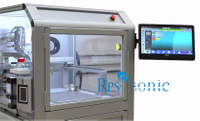20KHZ Explosion-proof grade ultrasonic homogenizer
| Model | SONO20-3000 |
| Frequency | 20KHZ |
| Power | 3000W |
| Voltage | 220V/110V |
| Temperature | 300 ºC |
| Pressure | 35 MPa |
| Intensity of sound | 60 W/cm² |
| Max Capacity | 20 L/Min |


Working principle of ultrasonic descaling
Cavitation effect
When ultrasonic waves propagate in liquids, they generate high-frequency pressure waves to form tiny bubbles (cavitation bubbles).
When bubbles collapse (implosion) instantly, local high pressure (up to 1000 atm) and high temperature (5000 K) are released, impacting the scale layer to loosen and peel off.
Microjet Impact
The microjet generated when the cavitation bubble breaks directly impacts the surface of the scale layer and mechanically crushes the sediment.
Vibration effect
The high-frequency vibration of ultrasonic waves causes shear stress between the scale layer and the base metal, resulting in fatigue shedding of the scale layer.
Ultrasonic descaling technology has been widely used in various industrial cleaning processes, such as cleaning heat exchangers, membrane separation equipment, industrial pipelines, and surface cleaning of integral devices. It can effectively remove various types of scale and blockages, including precipitation, rust, sediment, etc.
Technical advantages
No need for chemical agents: avoid corrosion of equipment or environmental pollution.
High efficiency and no dead angle: can clean complex structures (such as threads, inside of thin tubes).
Protect the substrate: do not damage the metal surface and extend the life of the equipment.
Online cleaning: some systems can operate without stopping, reducing downtime losses
 English
English








































































